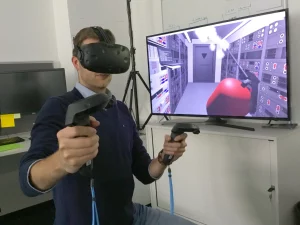Virtual and Augmented Reality (VR and AR) technologies have evolved rapidly in recent years, offering transformative experiences across various sectors. As 2024 unfolds, VR and AR continue to revolutionize industries like gaming, healthcare, education, retail, and more. This article explores the latest trends, benefits, and real-world case studies, helping you understand the potential of these immersive technologies.
Introduction to VR and AR
Virtual Reality (VR) and Augmented Reality (AR) are immersive technologies that transform how users interact with digital information.
- Virtual Reality: Provides a simulated environment using headsets, creating a sense of presence in a different world.
- Augmented Reality: Enhances real-world surroundings with digital overlays through devices like smartphones or AR glasses.
The global VR and AR market is expected to reach $296.9 billion by 2024, showing their potential across industries.
Top VR and AR Trends in 2024

Mixed Reality Integration
Mixed Reality (MR), a combination of AR and VR, blends digital elements into the physical environment. Companies like Microsoft with HoloLens and Meta’s Project Cambria are at the forefront, enabling users to interact seamlessly with 3D holograms and digital twins.
AI-Powered VR and AR
Artificial Intelligence (AI) is enhancing VR and AR experiences by providing personalized content, voice assistance, and real-time analytics. AI-powered AR apps like Google Lens enable real-time object recognition and contextual information delivery.
Immersive Training and Learning
VR and AR are redefining training and education by offering realistic simulations. Sectors like aviation, healthcare, and engineering are using VR to train professionals, improving safety and skills.
- Example: Boeing uses VR to train its pilots, reducing errors and enhancing preparedness.
AR in Retail and E-Commerce
Retailers are using AR to create interactive shopping experiences. AR apps allow users to visualize products in real-life settings, boosting customer confidence.
- Example: IKEA’s AR app lets users place virtual furniture in their homes to see how it fits.
Virtual Events and Meetings
As remote work becomes more prevalent, VR is reshaping virtual events and business meetings. Platforms like Spatial and AltspaceVR provide virtual spaces for collaboration and networking.
Gamification and Entertainment

Gaming remains a dominant sector for VR and AR, with more immersive games and experiences. Titles like Beat Saber (VR) and Pokemon Go (AR) are expanding, engaging users with new features and social interactions.
VR for Mental Health
VR is being used in therapy and mental health treatments, providing calming environments and exposure therapy for PTSD and anxiety disorders.
- Case Study: Oxford VR has developed VR therapy for social anxiety, proving effective in clinical trials.
AR Navigation and Smart Cities
AR is improving navigation in smart cities by overlaying information about streets, buildings, and routes. AR-enabled navigation apps offer real-time guidance, reducing confusion and enhancing mobility.
Real Estate Virtual Tours
Real estate companies use VR to offer 3D property tours, allowing buyers to explore homes remotely. This trend increases property viewings and reduces time spent in the decision-making process.
VR in Healthcare and Surgery
Surgeons are using VR simulations for preoperative planning and training, increasing the success rate of complex surgeries.
- Case Study: The Royal London Hospital uses VR simulations for reconstructive surgeries, improving patient outcomes.
Benefits of Adopting VR and AR
Enhanced User Engagement
VR and AR provide immersive experiences, capturing users’ attention and keeping them engaged longer than traditional content.
Improved Learning and Training Outcomes
AR and VR simulations offer hands-on experiences, improving knowledge retention and performance.
Increased Sales and Customer Satisfaction
AR helps customers visualize products, reducing hesitation and increasing conversion rates.
Cost-Effective Prototyping
Manufacturers use VR for virtual prototyping, reducing costs and speeding up the product development cycle.
Better Safety Measures
VR simulations in industries like construction and oil & gas allow workers to train in a risk-free environment, enhancing safety.
Accessibility and Convenience
VR and AR make information more accessible, allowing remote experiences that save time and resources.
Case Studies: Successful Implementations
Walmart’s VR Training Program
Walmart uses VR to train employees, improving customer service and decision-making skills. The program has been successful in reducing training costs while enhancing employee preparedness.
L’Oréal’s Virtual Makeup App
L’Oréal’s AR app, Modiface, allows users to try makeup virtually before purchasing, boosting sales and user engagement.
Ford’s Virtual Car Design
Ford uses VR for vehicle design, enabling teams to collaborate globally in a virtual space, accelerating the design process and reducing production costs.
Mayo Clinic’s VR Therapy
Mayo Clinic utilizes VR for pain management, helping patients alleviate pain through immersive environments like relaxing beaches or serene forests.
Challenges and Solutions
High Development Costs
Developing VR and AR solutions can be costly, requiring substantial initial investment.
- Solution: Companies can start with AR, which often requires less infrastructure, and gradually transition to VR.
User Adaptation
Some users face difficulties adapting to VR headsets or AR apps due to motion sickness or technical challenges.
- Solution: Regular user testing and feedback can help developers optimize user interfaces and improve comfort.
Privacy Concerns
Collecting and storing user data in VR and AR environments raises privacy issues.
- Solution: Implementing robust data encryption and transparent data policies can address these concerns.
Future Outlook for VR and AR
The future of VR and AR is promising, with anticipated advancements in hardware, software, and AI integration. Upcoming trends include:
- Holographic Displays: Advancements in holographic technology will enhance AR interactions without needing headsets.
- 5G Integration: Faster 5G networks will provide seamless, high-quality VR and AR experiences.
- Full-Body Tracking: VR will feature more sophisticated body-tracking capabilities, improving realism in virtual environments.
Conclusion
Virtual and Augmented Reality are at the forefront of digital innovation, with new trends emerging across industries. By adopting these technologies, companies can enhance engagement, increase sales, improve safety, and streamline training. While challenges exist, solutions are being developed rapidly to ensure a seamless VR and AR experience for users.
FAQs
1. What is the difference between VR and AR?
VR immerses users in a fully simulated environment, while AR overlays digital elements onto the real world.
2. How are VR and AR used in retail?
Retailers use AR for virtual try-ons, product visualization, and interactive marketing, while VR is used for virtual shopping experiences.
3. Are VR and AR technologies expensive?
Initial costs can be high, but they offer significant returns by increasing engagement, sales, and training outcomes.
4. What is mixed reality (MR)?
Mixed Reality blends digital elements with the physical environment, allowing interaction with holograms and 3D elements.




